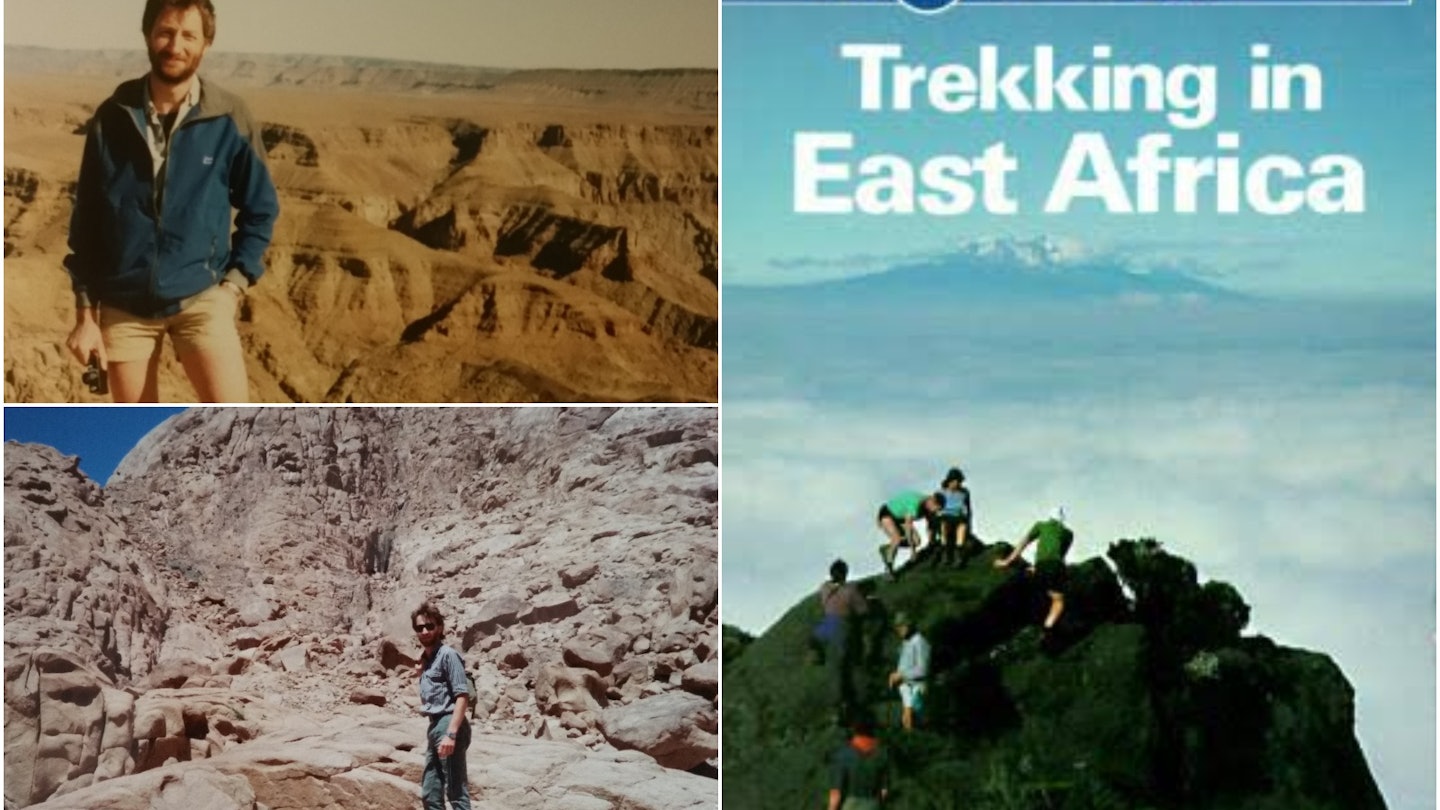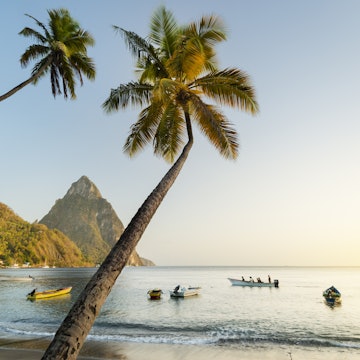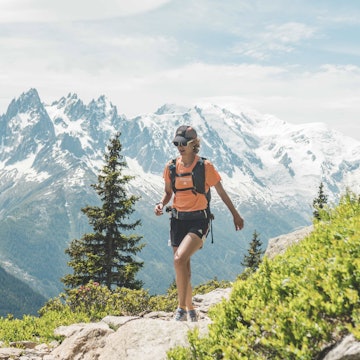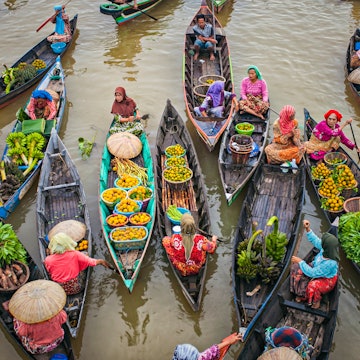
Trailblazers: Trekking in East Africa as a Lonely Planet writer in the 1990s
Jun 22, 2019 • 6 min read

(Clockwise from left) David in Namibia in 1991; Lonely Planet's Trekking East Africa guidebook and David in Egypt in 1989.
For more than 40 years, independent travellers have relied on Lonely Planet to provide advice and information, on anything from the cheapest beds to the best place for scuba diving. And for all that time, the legendary guidebooks have been created by Lonely Planet’s worldwide team of writers.
In LP’s early days, armed only with notebook, pen and shoe leather, these intrepid men and women created ground-breaking guidebooks to destinations such as China, Africa and India. In more recent times, the pen may have been replaced by a mobile phone, but LP writers still walk the streets, ride the trains and check the hotels, to ensure travellers always have recent and reliable information.
Then as now, Lonely Planet writers have always been proud to “tell it like it is”. So in this new series we ask some of LP’s old-hand writers to tell a few tales from their own travels, to reminisce a little, and compare their experiences past and present.
First cab off the rank is David Else, global nomad and LP old-hand, now entering his fourth decade as a professional travel writer.

The ferry came to a sudden halt with a gut-wrenching sound of metal on rock. Despite attempts by the crew (who’d been enjoying local hooch), the boat was stuck, and I was as close as I’ve ever been to shipwrecked.
This memorable event happened off the coast of Guinea-Bissau, where I’d taken the decrepit ferry to a remote island with a single hotel that needed checking for Lonely Planet’s West Africa guidebook. But thanks to the drunken captain that plan was scuppered, and I was marooned on a reef near a completely different island. As I waded ashore in the dark, trying to keep my backpack dry, and trying not to think about sharks, I thought to myself “the things I do for Lonely Planet”.
That was in the mid-1990s. I’d been hired by LP to cover six countries in West Africa, but it wasn’t my first time in this part of the world. I’d originally started travelling in Africa in the 1980s, where my trips included riding on trucks through Sudan, sailing by dhow to Zanzibar, and even reaching the fabled city of Timbuktu.

To fund my adventures I wrote articles and took photos for magazines and newspapers, and created some slim guidebooks for a couple of UK-based publishers. Everything was print, of course. This was years before the era of ‘digital products’ such as ebooks and travel websites, let alone blogs and Instagram.
Alongside my early writing, I worked for travel companies in places like Egypt, Namibia and Tanzania, organising safaris and leading treks on Mount Kenya, Kilimanjaro and other mountain areas. It was this experience that led to my first gig with Lonely Planet in 1991. Looking back, it was remarkably easy, yet a major turning point in my life.
At a trade book fair in London I met Tony Wheeler, Lonely Planet’s founder, just about the time LP was expanding and developing a series of trekking guidebooks. I said to Tony, "Would you be interested in a book about East Africa?", Tony said "Yes", and that was it. Of course, I had to prove I could string some decent words together and knew my way around the destination, but once I’d passed the “author test”, I started to work on the first edition of Trekking in East Africa. Over the next decade I spent more time in Africa than I did at home, eventually writing about 40 books for LP.

On my early trips in those pre-internet days, communication was by air mail letter. Anyone wanting to contact me would write to the Poste Restante (a mail-holding service) in Niamey, Harare or whatever city they knew I’d be passing through. Then I’d go to the main post office and queue in a dusty corridor, hoping for a red-and-blue-edged envelope with news from home.
When the fax machine was invented, it felt so amazingly modern. Receiving messages that were only days old, instead of weeks or even months old, certainly made my planet feel less lonely.
Then came email. But wifi was still a way off, so travellers used public computers in internet cafes. At least messages could be received and sent the same day, but download speeds were glacial. Oh, the many hours I spent in internet cafes from Cairo to Dakar, simply waiting for a screen to reload.

Technology progressed and mobile phones appeared. I remember staying in a backpackers’ hostel in Cape Town, where a bunch of travellers were hanging out in the bar. Somebody got a phone out of their bag and made a call. Everyone else just stared in amazement that a mere backpacker had such a wondrous new-fangled device.
Away from encounters with technology, I had many other memorable moments on the road in Africa. I once hitched-hiked back from Senegal via Niger across the Sahara, and got lost in a sandstorm. While on a walking safari in Zimbabwe, I was charged by elephants, and on another visit nearly had my canoe flattened by a hippo leaping from a high bank into the water. Who even knew hippos could leap? Back in West Africa, I was once stuck in Bamako with scheduled flights grounded, but scored a ride on a smugglers' plane into Freetown in Guinea (US$100 cash, no receipt, no ticket, no questions). And all that's before I get onto the escapades I've had while sampling some of the continent's more disreputable hotels on behalf of Lonely Planet's loyal readership.
Around the turn of the millennium I handed the Africa baton to other Lonely Planet writers, and focused instead on my own backyard, writing several editions of LP’s landmark England and Great Britain guidebooks. I still got my boots dirty by working on Walking in Britain, and still kept my travel bug alive with trips to India, Mexico, Greenland, France and Switzerland.

During this time, my wife and I had children, and on some of my research tours around Britain I was joined by my young daughter. Since then, not surprisingly, family travel has become a specialist topic, and I’ve written various articles for parents on locations from Disneyland to Sri Lanka.
In 2017, things turned full circle, and I went back to Africa to cover Zanzibar for Lonely Planet’s Tanzania and East Africa guidebooks. Of course, a lot had altered in Zanzibar since my first visit back in 1984 – there were many more hotels, all with wifi, and regular high-speed boats rather than the occasional dhow – but the friendliness of the people, the labyrinthine streets of the Old Town and the unbelievably blue waters of the Indian Ocean were all unchanged.
My research included visiting a hotel on a small islet off the mainland. On the way back the tide was too low, the boat was beached, and – you guessed it – I had to wade ashore. A lifetime of travel, and I’m still saying “the things I do for Lonely Planet”.
I wouldn’t change it for the world.















